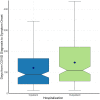New-onset and persistent neurological and psychiatric sequelae of COVID-19 compared to influenza: A retrospective cohort study in a large New York City healthcare network
- PMID: 35706352
- PMCID: PMC9349863
- DOI: 10.1002/mpr.1914
New-onset and persistent neurological and psychiatric sequelae of COVID-19 compared to influenza: A retrospective cohort study in a large New York City healthcare network
Abstract
Objectives: Neurological and neuropsychiatric manifestations of post-acute SARS-CoV-2 infection (neuro-PASC) are common among COVID-19 survivors, but it is unknown how neuro-PASC differs from influenza-related neuro-sequelae. This study investigated the clinical characteristics of COVID-19 patients with and without new-onset neuro-PASC, and of flu patients with similar symptoms.
Methods: We retrospectively screened 18,811 COVID-19 patients and 5772 flu patients between January 2020 and June 2021 for the presence of new-onset neuro-sequelae that persisted at least 2 weeks past the date of COVID-19 or flu diagnosis.
Results: We observed 388 COVID-19 patients with neuro-PASC versus 149 flu patients with neuro-sequelae. Common neuro-PASC symptoms were anxiety (30%), depression (27%), dizziness (22%), altered mental status (17%), chronic headaches (17%), and nausea (11%). The average time to neuro-PASC onset was 138 days, with hospitalized patients reporting earlier onset than non-hospitalized patients. Neuro-PASC was associated with female sex and older age (p < 0.05), but not race, ethnicity, most comorbidities, or COVID-19 disease severity (p > 0.05). Compared to flu patients, COVID-19 patients were older, exhibited higher incidence of altered mental status, developed symptoms more quickly, and were prescribed psychiatric drugs more often (p < 0.05).
Conclusions: This study provides additional insights into neuro-PASC risk factors and differentiates between post-COVID-19 and post-flu neuro-sequelae.
Keywords: COVID-19; influenza; neuropsychiatry; new-onset symptoms.
© 2022 The Authors. International Journal of Methods in Psychiatric Research published by John Wiley & Sons Ltd.
Conflict of interest statement
None.
Figures







References
-
- Carvalho‐Schneider, C. , Laurent, E. , Lemaignen, A. , Beaufils, E. , Bourbao‐Tournois, C. , Laribi, S. , Flament, T. , Ferreira‐Maldent, N. , Bruyere, F. , Stefic, K. , Gaudy‐Graffin, C. , Grammatico‐Guillon, L. , & Bernard, L. (2021). Follow‐up of adults with noncritical COVID‐19 two months after symptom onset. Clinical Microbiology and Infection, 27(2), 258–263. 10.1016/j.cmi.2020.09.052 - DOI - PMC - PubMed
-
- Davis, H. E. , Assaf, G. S. , McCorkell, L. , Wei, H. , Low, R. J. , Re'em, Y. , Redfield, S. , Austin, J. P. , & Akrami, A. (2021). Characterizing long COVID in an international cohort: 7 months of symptoms and their impact. eClinicalMedicine, 38, 101019. 10.1016/j.eclinm.2021.101019 - DOI - PMC - PubMed
MeSH terms
LinkOut - more resources
Full Text Sources
Medical
Miscellaneous

